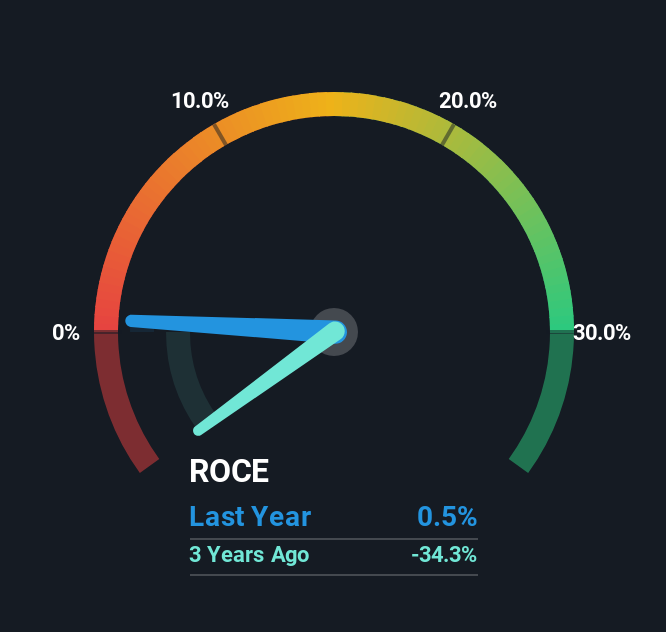- Israel
- /
- Interactive Media and Services
- /
- TASE:TGTR
Returns On Capital Signal Difficult Times Ahead For Together Pharma (TLV:TGTR)
Ignoring the stock price of a company, what are the underlying trends that tell us a business is past the growth phase? A business that's potentially in decline often shows two trends, a return on capital employed (ROCE) that's declining, and a base of capital employed that's also declining. This reveals that the company isn't compounding shareholder wealth because returns are falling and its net asset base is shrinking. And from a first read, things don't look too good at Together Pharma (TLV:TGTR), so let's see why.
What Is Return On Capital Employed (ROCE)?
For those that aren't sure what ROCE is, it measures the amount of pre-tax profits a company can generate from the capital employed in its business. The formula for this calculation on Together Pharma is:
Return on Capital Employed = Earnings Before Interest and Tax (EBIT) ÷ (Total Assets - Current Liabilities)
0.0052 = ₪375k ÷ (₪152m - ₪80m) (Based on the trailing twelve months to June 2025).
Therefore, Together Pharma has an ROCE of 0.5%. In absolute terms, that's a low return and it also under-performs the Interactive Media and Services industry average of 13%.
See our latest analysis for Together Pharma

Historical performance is a great place to start when researching a stock so above you can see the gauge for Together Pharma's ROCE against it's prior returns. If you want to delve into the historical earnings , check out these free graphs detailing revenue and cash flow performance of Together Pharma.
What Does the ROCE Trend For Together Pharma Tell Us?
We aren't too thrilled by the trend because ROCE has declined 86% over the last five years and despite the capital raising conducted before the latest reports, the business has -22% less capital employed.
On a side note, Together Pharma's current liabilities have increased over the last five years to 53% of total assets, effectively distorting the ROCE to some degree. If current liabilities hadn't increased as much as they did, the ROCE could actually be even lower. And with current liabilities at these levels, suppliers or short-term creditors are effectively funding a large part of the business, which can introduce some risks.
The Bottom Line
In short, lower returns and decreasing amounts capital employed in the business doesn't fill us with confidence. Unsurprisingly then, the stock has dived 88% over the last five years, so investors are recognizing these changes and don't like the company's prospects. With underlying trends that aren't great in these areas, we'd consider looking elsewhere.
One final note, you should learn about the 3 warning signs we've spotted with Together Pharma (including 1 which shouldn't be ignored) .
While Together Pharma isn't earning the highest return, check out this free list of companies that are earning high returns on equity with solid balance sheets.
Valuation is complex, but we're here to simplify it.
Discover if Together Pharma might be undervalued or overvalued with our detailed analysis, featuring fair value estimates, potential risks, dividends, insider trades, and its financial condition.
Access Free AnalysisHave feedback on this article? Concerned about the content? Get in touch with us directly. Alternatively, email editorial-team (at) simplywallst.com.
This article by Simply Wall St is general in nature. We provide commentary based on historical data and analyst forecasts only using an unbiased methodology and our articles are not intended to be financial advice. It does not constitute a recommendation to buy or sell any stock, and does not take account of your objectives, or your financial situation. We aim to bring you long-term focused analysis driven by fundamental data. Note that our analysis may not factor in the latest price-sensitive company announcements or qualitative material. Simply Wall St has no position in any stocks mentioned.
About TASE:TGTR
Together Pharma
Through its subsidiaries, engages in growing, production, storage, and distribution of medical cannabis products in Israel.
Excellent balance sheet with low risk.
Similar Companies
Market Insights
Community Narratives



